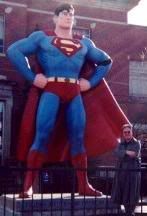| Pop Culture Gadabout | ||
|
Saturday, February 27, 2010 ( 2/27/2010 11:25:00 AM ) Bill S. THE DEAD MOUSE IN THE WALLS: Watching an episode of Stephen Fry in America the other day, I caught a segment where the British comedian/raconteur makes a reference to Hawaii 5-O during a visit to the 50th state. You must hear this all the time, he tells his native guide, and as he did this, I found myself thinking, “Lewis Trondheim made a similar joke in his new Little Nothings collection.” Strolling the streets of Venice, the French cartoonist states that it looks like the Venetian Casino in Las Vegas. “I bet that joke’s been told millions of times before,” Trondheim thinks to himself. The third volume collecting Trondheim’s personal one-page comic journaling, Little Nothings: Uneasy Happiness (NBM) provides a delightful introduction to the Dungeon co-creator’s smartly observant take on the world. Employing a similar storytelling strategy to American Elfster James Kochalka -- though where the New England diarist portrays himself as an elf-eared quasi-innocent, the Frenchman draws himself as a cartoon chicken -- Trondheim sidesteps the sometimes cloying whimsy that can mar the American artist’s autobiographical work. Looking to buy seeds for some exotic plants, he passes by a nursery, stating, “I don’t trust a nursery that’s selling garden gnomes.” No French elves here, folks. Our hero’s adventures in this volume include treks to Reunion Island and Fiji, time spent at the Angouleme International Comics Festival, alongside trenchant stay-at-home refllections of 21st century urban life. In one six-strip sequence, for instance, the cartoonist tries to prod the family cat into taking care of a mouse that has gotten into the apartment: he’s unsuccessful and winds up with a dead rodent trapped in the walls, stinking up the place. “It will smell for a few days and afterwards it will mummify,” he tries to tell his wife, unsure if he’s convincing either her or himself. Trondheim plays his funny animal figures against some gorgeously rendered ink and watercolor settings: an ornately stain-glassed cathedral, tropical waterfalls, finely detailed cityscapes. The approach grounds his “small” observations, the thoughts of a man who’s outgrown some of his youthful cynicism (“Can you believe it?” he says of himself after noting a beautiful moonrise. “I’m getting weirdly positive.”) but is still capable of noting the infringement of commercial ugliness and his own identifiably human quirks. Thoughtful and amusing, Trondheim’s Little Nothings belie their humble title. Labels: art comics # |Thursday, February 25, 2010 ( 2/25/2010 06:08:00 AM ) Bill S. DAY LATE MUSIC VIDEO: Here's one of my musical heroes, Ray Davies, singing a live version of the title track to Working Man's Cafe. What more d'ya need? # | Monday, February 22, 2010 ( 2/22/2010 09:16:00 PM ) Bill S.  “IT’S HARD TO GET FEELINGS ACROSS, BUT IT LOOKS LIKE THIS SKY IS GONNA GO ON FOR A WHILE.” A likable All-Ages fantasy romance, Ayami Kazama’s The World I Create (CMX) tells a series of tales about the students at an unusual high school. Each one is a projectionist -- gifted with the ability to take an image in their head and give it form -- and their schooling centers on honing this power through the aid of lanterns. With the exception of a lightweight multi-cast epilog, each of World’s stories focuses on a boy and girl as they struggle to deal with their varying skill levels and with their teenage attraction. “IT’S HARD TO GET FEELINGS ACROSS, BUT IT LOOKS LIKE THIS SKY IS GONNA GO ON FOR A WHILE.” A likable All-Ages fantasy romance, Ayami Kazama’s The World I Create (CMX) tells a series of tales about the students at an unusual high school. Each one is a projectionist -- gifted with the ability to take an image in their head and give it form -- and their schooling centers on honing this power through the aid of lanterns. With the exception of a lightweight multi-cast epilog, each of World’s stories focuses on a boy and girl as they struggle to deal with their varying skill levels and with their teenage attraction.Thus, in one story, “Last Platonic Blue,” we meet a young boy Akitsu, who spends more of his time working on other students’ lanterns than he does developing his own abilities, and upper classmate named Suyoka, who is on the verge of losing her capacity to project. Their briskly captured relationship believably alternates between tenseness and attraction. For all their unexplained abilities (which could stand in for simple creativity or adolescent empowerment), these are convincing manga kids. No dubious sexual politics -- just stories of tentative, budding relationships. A sweet little book, airily illustrated, though I’m unsure from the packaging whether it’s meant as a stand-alone volume or the start of a longer series. (CMX plasters “Read the complete story inside!” on the back/front cover, but the book’s spine indicates that it’s Volume One.) I know I’d be ready to read a second collection of projectionist stories, though. Labels: sixty-minute manga # |Sunday, February 21, 2010 ( 2/21/2010 07:57:00 AM ) Bill S.  “THESE STORIES ONLY EXIST FOR HUMANS.” As a writer, I could only be intrigued by the title of Saka Esuno’s horror manga series, Hakano and the Terror of Allegory (Tokyopop). Terror of Allegory? How about the Menace of Metaphor? The Shock of Simile? I’ve been there, pal! “THESE STORIES ONLY EXIST FOR HUMANS.” As a writer, I could only be intrigued by the title of Saka Esuno’s horror manga series, Hakano and the Terror of Allegory (Tokyopop). Terror of Allegory? How about the Menace of Metaphor? The Shock of Simile? I’ve been there, pal!Turns out, though, as presented in the Older Teen-rated series, an “allegory” is a living manifestation of an urban legend. Aso Daisuke, a former cop turned p.i., specializes in dealing with these beasties; when confronted with a client menaced by one of these creations, he begins to hiccup, living out the old kid’s tale that if you hiccup 100 times, you’ll die. It thus becomes paramount that Aso vanquish each allegory before he reaches that magic number. To top things off, our heroic detective also has a girly looking allegory haunting him personally (though why this particular ‘un doesn’t set off the guy's hiccups is not explained): Hanako from the bathroom, a techno-savvy schoolgirl figure capable of traveling from toilet to toilet -- where she’s able to lend a hand in the fight against malicious or vengeful allegories. We’re introduced to this somewhat nonsensical set-up through Kanae Hiranuma, a young girl brought into Aso’s agency after she is haunted by an axe-wielding boogeyman under her bed. “Some stories have a power that can’t be explained,” Aso explains. “Some people tend to attract these stories on a genetic level.” On hearing the urban myth of the Man Under the Bed from a girlfriend, Kanae so connected to the story that the myth became manifest. Now she’s afraid to go to sleep else the axe-holding creature attack her when she’s most helpless. It’s not giving much away to reveal that Aso saves his client from the creature under the bed -- or that Kanae becomes the p.i.’s office assistant. We need her as the eyes of normalcy to balance the eccentric Aso and other-worldly Hanako. (We know Aso is out there because the shelves of his office are lined with erotic manga -- and the guy doesn’t even realize how this might look to potential clients.) She proves a good Watson to whom Aso can explain the rules of each urban myth. In addition to Kanae’s confrontation with the nameless bed man, Aso’s agency takes on two more cases in the series’ first volume: one involves a plain girl who is possessed by a needy allegory called the Slit Mouthed Woman; the last concerns Human-Faced Fish. (Esuno includes a one-page afterword describing the basics of each legend in modern Japanese culture.) While Kanae is an innocent victim of her particular allegory, the haunted clients in the other two cases are more culpable. In the two-part fish tale, victim Yousuke is the sole survivor of a school bus crash who witnessed his drowning classmates as they were devoured by river fish. He’s attacked by hybrids that look less lie human-face fish than they do fished-headed humans. At first, we think Yousuke is just an unlucky survivor like the kids in the Final Destination flicks, though we ultimately learn his allegoried classmates have a good motive for exacting their vengeance. As horror manga, Hanako and the Terror of Allegory isn’t as unsettling as it could be: there are terrors, after all, which reflect the characters’ primal fears, yet Esuno doesn’t delve as deeply into ‘em as he could. He’s instead content to blend the tongue-in-cheek with the disturbing, which doesn’t always work as smoothly as you’d wish: the inclusion of a sexual assault subplot into the school bus story comes across more than a little gratuitous, for instance. Too, the insertion of Hanako’s parapsychology equipment -- her use of computer and sensors to “devisualize” allegories -- broaches the intentionally ludicrous technobabble of Ghostbusters. Difficult to be truly creeped out when you keep hearing the phrases, “Don’t cross the streams” and “total protonic reversal” in the back of your head. Still, Esuno (first known to American manga readers for his teen survival series Future Diary) slips some effective visuals into the series: a two-page spread featuring the Slit-Mouthed Woman and the young man who had been unable to say the real reasons he was attracted to her, the first time we see the Man under Kanae’s bed, scenes of Aso in a rooftop fight with the fishy allegories. There’s even an emotional moment where the school bus survivor finds the naked body of the girl he loves, though we don’t really know enough about the character in question for it to have as much impact as it could. In general, the artist’s treatment of his human and monster characters is appealing, and his stories zip along breezily. If I were to make a comparison to any American comic series, I’d look to the brief run of Marvel monster series from the 1970’s (Tomb of Dracula, Werewolf by Night, the original Ghost Rider). Diverting little titles all, though less about the Terror and more about the occasional Thrill. But, I know, The Occasional Thrill of Allegory makes for a much less snappy title. Labels: sixty-minute manga # | |
|
|

